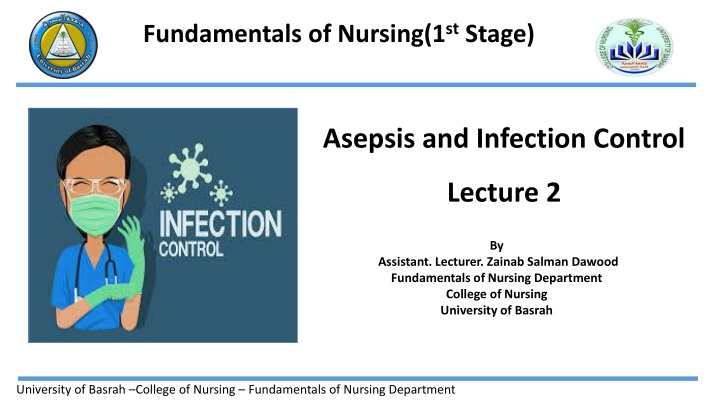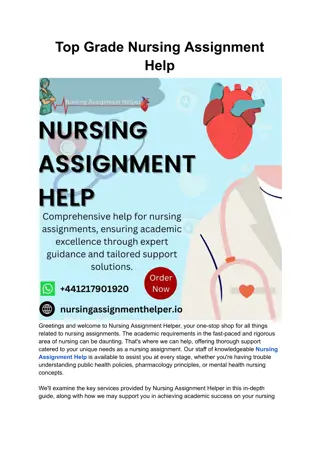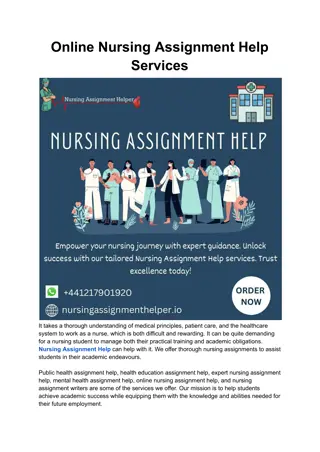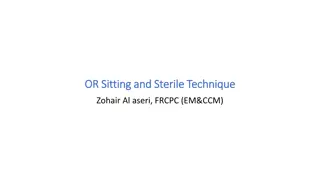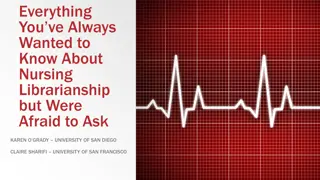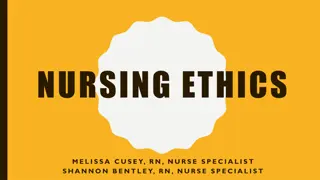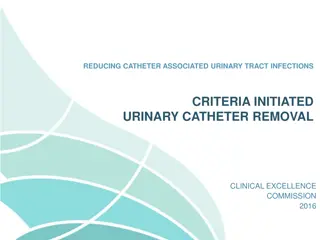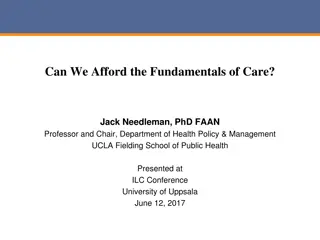Asepsis and Infection Control Fundamentals in Nursing
This lecture discusses asepsis and infection control in nursing, covering topics such as medical and surgical asepsis, infectious agents, cross infection, types of microorganisms causing infection (bacteria, viruses, fungi, parasites), and more. Understanding these concepts is essential for maintaining a safe healthcare environment and preventing the spread of infections in clinical settings.
Download Presentation

Please find below an Image/Link to download the presentation.
The content on the website is provided AS IS for your information and personal use only. It may not be sold, licensed, or shared on other websites without obtaining consent from the author.If you encounter any issues during the download, it is possible that the publisher has removed the file from their server.
You are allowed to download the files provided on this website for personal or commercial use, subject to the condition that they are used lawfully. All files are the property of their respective owners.
The content on the website is provided AS IS for your information and personal use only. It may not be sold, licensed, or shared on other websites without obtaining consent from the author.
E N D
Presentation Transcript
Fundamentals of Nursing(1st Stage) Asepsis and Infection Control Lecture 2 By Assistant. Lecturer. Zainab Salman Dawood Fundamentals of Nursing Department College of Nursing University of Basrah University of Basrah College of Nursing Fundamentals of Nursing Department
Glossary Asepsis: Is the absence of organism causing disease. Medical asepsis(clean technique):involves procedures and practices that reduce the number and transfer of pathogens. Medical asepsis procedures include performing hand hygiene and wearing gloves. Surgical asepsis(sterile technique):includes practices used to render and keep objects and areas free from microorganisms. Surgical asepsis procedures include inserting an indwelling urinary catheter or inserting an IV catheter. University of Basrah-College of Nursing Fundamentals of Nursing Department
Infection: is the invasion and multiplication of pathogenic microorganisms in body tissue that results in cellular injury. These microorganisms are called infectious agents. Infectious agents: is capable of being transmitted to a client by direct or indirect contact, through a vehicle or airborne route. University of Basrah-College of Nursing Fundamentals of Nursing Department
Cross infection: is an infection transmitted from an infected person or an object to other persons or objects. Colonization: is the multiplication of microorganisms on or within a host that does not result in cellular injury, an example of colonization is the normal flora (microorganisms) in the intestines. University of Basrah-College of Nursing Fundamentals of Nursing Department
Types of microorganism causing infection 1- Bacteria: the most significant and most commonly observed infection-causing agents in health care institutions, can be categorized in various ways. there are two types: Commensal bacteria :found as normal flora of healthy humans. These have a significant protective role by preventing colonization of pathogenic microorganisms. Pathogenic bacteria: have greater virulence, and cause infections. University of Basrah-College of Nursing Fundamentals of Nursing Department
2- Virus: is the smallest of all microorganisms, visible only with an electron microscope such as hepatitis B, C viruses and HIV, influenza viruses. 3- Fungi: plant-like organisms (molds and yeasts) that also can cause infection, are present in the air, soil, and water. 4- Parasites: are organisms that live on or in a host and rely on it for nourishment include protozoa. University of Basrah-College of Nursing Fundamentals of Nursing Department
Stages of infections 1. Incubation stage: the incubation period is the interval between the pathogen s invasion of the body and the appearance of symptoms of infection. 2. Prodromal stage:a person is most infectious during the prodromal stage. Early signs and symptoms of disease are present, but these are often vague and nonspecific, ranging from fatigue and malaise to a low-grade fever. This period lasts from several hours to several days. University of Basrah-College of Nursing Fundamentals of Nursing Department
3 .Foul stage of illness: the presence of specific signs and symptoms indicates the full stage of illness. The type of infection determines the length of the illness and the severity of the manifestations. 4. Convalescent stage: the convalescent period is the recovery period from the infection. Convalescence may vary according to the severity of the infection and the patient s general condition. University of Basrah-College of Nursing Fundamentals of Nursing Department
Types of infections 1. Localized infections: are limited to a defined area or single organ with symptoms that resemble inflammation (redness, tenderness, hotness, and swelling) 2. Generalized: such as pneumonia (in the lungs). 3. Systemic infections: affect the entire body and involve multiple organs. University of Basrah-College of Nursing Fundamentals of Nursing Department
Nosocomial Infections Nosocomial infections are infections acquired in the hospital or other health care facilities that were not present or incubating at the time of the client s admission. Nosocomial infections include those infections that become symptomatic after the client is discharged as well as infections among medical personnel. Most nosocomial infections are transmitted by health care personnel who fail to practice proper hand washing procedures or change gloves between client contacts. University of Basrah-College of Nursing Fundamentals of Nursing Department
Types of Nosocomial Infections 1. Nosocomial of urinary tract infection. 2. Nosocomial of respiratory tract infection. 3. Nosocomial of blood stream infection. 4. Nosocomial of surgical site infection. University of Basrah-College of Nursing Fundamentals of Nursing Department
Chain of infection 1. Infectious agent 2. Reservoir resident, health care worker, environment, equipment 3. Portal of exit excretions, wound drainage, urine, feces, blood, saliva 4. Method of transmission airborne, droplet, contact, food/water, animals or insects 5. Portal of entry non-intact skin, mucus membranes, respiratory tract, urinary tract, reproductive tract 6. Susceptible host resident, health care worker, families, visitors University of Basrah-College of Nursing Fundamentals of Nursing Department
Cuts through: Immunizations, Screen healthcare staff Cuts through: hand hygiene, sterilization, antibiotics Infectious agent Cuts through: hand hygiene ,wear gloves , use masks and appropriate protective gear proper disposal of needles/sharps Susceptible host Reservoir Cuts through: transmission-based precautions, sterilization or use of disposable supplies Chain of infection Portal of exit from reservoir Portals of entry Cuts through: Means of transmission Cuts through : dry intact dressing, hand hygiene, wear gloves if contact with body fluids, cover nose and mouth when sneezing Hand hygiene, Use pesticides to eliminate vectors, Adequate refrigeration University of Basrah-College of Nursing Fundamentals of Nursing Department
Body defenses against infection The body has some natural defenses to protect it from infections: 1. Skin and normal flora: intact skin acts as a mechanical barrier against the entry of pathogens. 2. Mucous membranes: lining the respiratory, reproductive, gastrointestinal, and urinary tracts. The mucus is sticky and traps foreign materials before they can cause damage. 3. Cilia: (fine microscopic hairs) lining the respiratory tract propel the mucus and trapped microbes out of the body. University of Basrah-College of Nursing Fundamentals of Nursing Department
4. Coughing and sneezing: remove foreign materials from the respiratory tract. 5. Hydrochloric acid: strong chemical that is produced in the stomach destroys many microbes. 6. Eyes: are protected by tears that provide a flushing action to remove most microbes that enter the eyes. University of Basrah-College of Nursing Fundamentals of Nursing Department
7. Inflammatory Response: the inflammatory response is a protective mechanism that eliminates the invading pathogen and allows for tissue repair to occur. Inflammation helps the body to neutralize, control, or eliminate the offending agent and to prepare the site for repair. 8. Immunity response :involves specific body responses to an invading foreign protein, such as bacteria, or in some cases, to the body s own proteins. University of Basrah-College of Nursing Fundamentals of Nursing Department
Factors Affecting the Risk for Infection 1. Integrity of skin and mucous membranes, which protect the body against microbial invasion. 2. PH levels of the gastrointestinal and genitourinary tracts, as well as the skin, which help to ward off microbial invasion. 3. Integrity and number of the body s white blood cells, which provide resistance to certain pathogens. 4. Age, sex, race, and hereditary, which influence susceptibility. Neonates and older adults appear to be more vulnerable to infection. University of Basrah-College of Nursing Fundamentals of Nursing Department
5. Immunizations, natural or acquired, which act to resist infection. 6. Level of fatigue, nutritional and general health status, the presence of preexisting illnesses, previous or current treatments, and certain medications, which play a part in the susceptibility of a potential host. 7. Stress level, which if increased, may adversely affect the body s normal defense mechanisms. 8. Use of invasive or indwelling medical devices, which provide exposure to and entry for more potential sources of disease-producing organisms, particularly in a patient whose defenses are already weakened by disease. University of Basrah-College of Nursing Fundamentals of Nursing Department
An organisms potential to produce disease in a person depends on a variety of factors, including: 1. Number of organisms 2. Virulence of the organism, or its ability to cause disease 3. Competence of the person s immune system 4. Length and intimacy of the contact between the person and the microorganism University of Basrah-College of Nursing Fundamentals of Nursing Department
Infection control for health care workers 1. Hand hygiene (hand washing) 2. Using personal protective equipment such as gloves, mask, gown, goggles, cover shoes. 3. Vaccination such as hepatitis B vaccine. University of Basrah-College of Nursing Fundamentals of Nursing Department
Nursing assessment 1. The extent of nursing interventions depends on the susceptibility of the host, the virulence of the organism, and the patient s signs and symptoms. 2. Inquire about the patient s immunization status and previous or recurring infections. 3. Observe nonverbal cues and gather information about the history of the current disease. University of Basrah-College of Nursing Fundamentals of Nursing Department
4. Observing for signs and symptoms of a local or systemic infection: A localized infection can result in redness, swelling, warmth in the involved area, pain or tenderness, and loss of function of the affected part. Manifestations of a systemic infection include fever, often accompanied by an increase in pulse and respiratory rate, lethargy, anorexia, and tenderness and enlargement of lymph nodes that drain the area when an infection is present. University of Basrah-College of Nursing Fundamentals of Nursing Department
Nursing diagnosis 1. Risk for Infection related to presence of chronic disease 2. Altered immune response related to effects of medication 3. Altered skin integrity related to malnutrition; presence of invasive or indwelling medical device; lack of proper immunization 4. Impaired Oral Mucous Membrane related to ineffective dental hygiene; trauma; side effect of medication; presence of invasive medical device 5. Anxiety related to high risk for infection; social isolation University of Basrah-College of Nursing Fundamentals of Nursing Department
Planning 1. Demonstrate effective hand hygiene and good personal hygiene practices 2. Use appropriate cleansing and disinfecting techniques 3. Demonstrate an awareness of the necessity of proper immunizations University of Basrah-College of Nursing Fundamentals of Nursing Department
Implementation The practice of asepsis includes all activities to prevent infection or break the chain of infection. The nurse uses aseptic techniques to halt the spread of microorganisms and minimize the threat of infection. Evaluation Evaluate correct apply of hand hygiene and correct use of personal protective equipment University of Basrah-College of Nursing Fundamentals of Nursing Department
Thanks University of Basrah College of Nursing Fundamentals of Nursing Department
